After losing his leg to cancer, Terry Fox made it his mission to run across Canada to raise awareness and money for cancer research. Using a custom prosthetic leg, he began his journey in St. Johns, Newfoundland, in April 1980, driving over 5,000 miles in 143 days. In September 1980, he was forced to stop the Marathon of Hope in Thunder Bay, Ontario, as the cancer spread to his lungs. He died a month before his 23rd birthday.
Fox was awarded the Lou Marsh Trophy in 1980 as Canada's Athlete of the Year as a companion of the Canadian Order. He was appointed a person of national importance by the Government of Canada. He was inducted into the Canadian Sports Hall of Fame and has had many schools, institutions and landmarks named in his honor. The annual Terry Fox Run has raised more than $ 800 million for cancer research. The Marathon of Hope raised $ 24 million by February 1981.
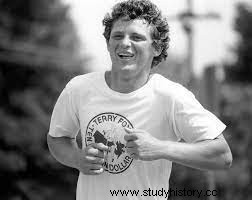
Early life
Terry Fox had three siblings and was the second child of Betty and Rolly Fox. Rolly worked as a switch for the Canadian National Railway and met Betty in Winnipeg. All their children were born there. Calm, tired of the cold Winnipeg winters, moved to Vancouver, British Columbia, in 1966. The family moved west to Port Coquitlam, a small town east of Vancouver.
Early Athletics
In high school, Terry Fox's favorite sport was basketball. In grade 8, Terry was only five feet tall and had little natural ability, but he was determined to get on the school basketball team. His best friend, Doug Alward, also loved basketball and had natural talent. The coach suggested that Terry should try cross-country running and wrestling instead. Fox started running, but did not give up his dream of playing basketball. He trained every morning before school and in the summer. In class 8, he was last on the team's lineup and played only once during the entire season. In Class 10, he and Alward started guards on the Mary Hill Junior High team. The two shared the school's award for athlete of the year.
A year later, Fox was selected as the starting guard at Port Coquitlam High School Ravens. He also ran cross-country skiing, played football and rugby. He was the co-winner of the school's athlete of the year award in class 12. At the time, Fox was a better basketball player, and Alward had become a skilled cross-country skier. Fox's determination was again recognized at Simon Fraser University where he made the school's junior varsity basketball team.
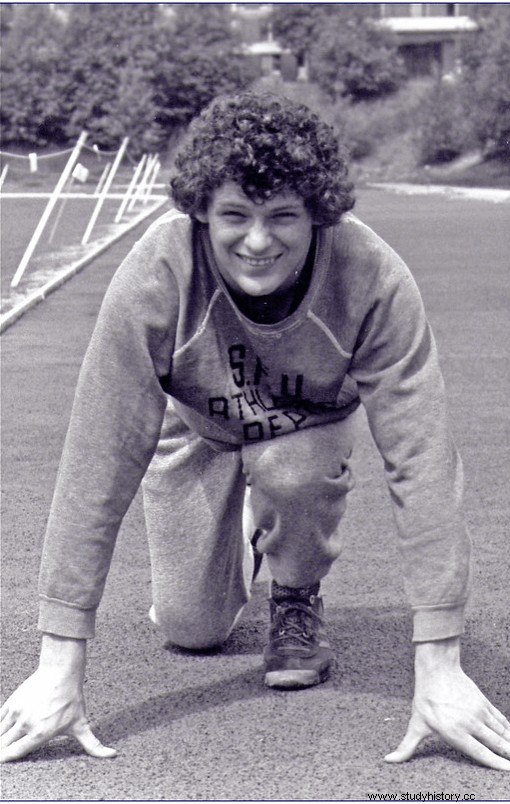
Diagnosis and Surgery
Terry Fox first began to feel pain in his leg in 1976. In November of that year, he put a truck backwards while driving on the highway. The car was wrecked, but Fox escaped without noticeable damage. The only problem was a sore right knee, which Fox assumed he must have injured during the crash. The pain returned in December, but this time Fox thought it might be a cartilage problem due to the stress of playing so much basketball. In February 1977, he visited the SFU health center, where he was prescribed painkillers.
In early March, Fox returned from a training run with intense pain. He visited a GP who suspected that his injury was more serious than a cartilage problem. Terry and his father Rolly drove to the Royal Columbia Hospital in New Westminster, where they were seen by an orthopedic surgeon. The doctor performed an X-ray and suspected that Fox had osteogenic sarcoma, a type of bone cancer that usually starts in the knee. His suspicion was confirmed after a bone scan on March 4. Because the cancer spreads rapidly, doctors felt that Fox's best chance of survival was to amputate his right leg and start chemotherapy.
Fox spent the next few days surrounded by loved ones. His classmates from SFU brought their homework to the hospital. Teammates stopped for a visit, as did Terri Fleming, Fox's basketball coach from Port Coquitlam High School. The night before the operation, Fleming gave Fox a Runner's World article about Dick Traum, an amputee who ran the New York City Marathon. The next morning, Fox showed the article to his nurse and told her, "One day I will do something like this."
And on March 9, 1977, when Fox was just 18 years old, the doctors amputated Fox's right leg
Rehabilitation and Chemotherapy
Within weeks of recovering from surgery, Fox underwent a leg prosthesis. In addition to physical therapy, Fox began a 16-month chemotherapy program at the British Columbia Cancer Control Agency in Vancouver. He would visit the clinic every three weeks for treatment. The medication gave him some minor side effects, including nausea and falling hair. But despite the illness, he felt lucky compared to those at the clinic who were dying. Not only did he feel compassion for them, but also a sense of responsibility that came with being a survivor.
Wheelchair Basketball
In the summer of 1977, Fox received a phone call from Rick Hansen. Hansen asked Fox if he wanted to join the basketball cable team in Vancouver Cable Cars. Fox practiced hard, his hands blistering and bleeding as he learned to play basketball differently while undergoing chemotherapy. By the end of the summer, Fox had joined the cable cars and competed in the national championships in wheelchair basketball in 1977. Fox played with the cable car for three years and won the national championship two years in a row.
From 1979-1980, Fox was selected to star in the North American Wheelchair Basketball Association. At the time, he played three days a week, using a wheelchair that was given to him as a gift from his father's colleagues on the National Railway. He also wanted to exercise in the wheelchair on roads and trails, and when he got tired of flat surfaces, he climbed both Westwood and Burnaby Mountain in the wheelchair.
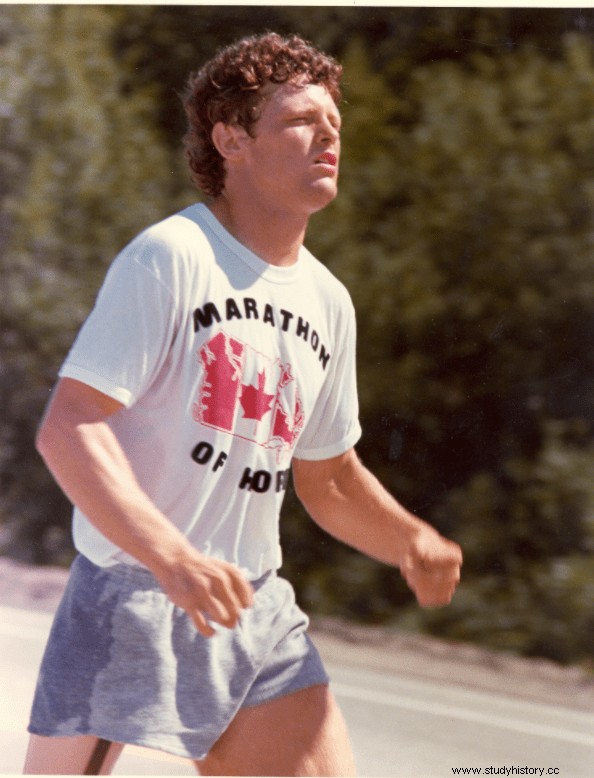
The Dream
Fox had another goal. During the months of chemotherapy, he witnessed the suffering of other cancer patients and knew he needed to help them in some way. The night before the operation, he read an article about Dick Traum, an amputee who ran the New York City Marathon. Inspired by Traum's example, Fox made it his mission to run across Canada to raise awareness and funding for cancer research.
When he started training, Fox ran around the track at the local junior high school. In mid-February 1979 he was able to run half a kilometer around the track, and at the end of the month he ran one kilometer. His prosthesis, Ben Speicher, modified the prosthetic leg so that it could better withstand the effects of running. But even with the changes, it made Fox feel difficult and uncomfortable. Still, he persevered.
In mid-August, he was preparing for a race in Prince George, British Columbia. Although he originally planned to run the 8.5-mile race, Fox ended up running the 17-mile version with his friend Doug Alward and brother Darrell. Fox finished last, 10 minutes behind the last two-legged runner.
Plans
The Prince George race convinced Fox that he was ready to start our journey across Canada the following spring. Considering a start date, it was time to tell his parents about his plan, because by that time only Alward and another friend, Rika Noda, had known about it. His mother thought he was crazy. The father simply asked when he was planning to start.
When Fox started the Marathon of Hope in April 1980, he had logged more than 5,000 km in training races. He also received support from the Canadian Cancer Society and the War Amputations of Canada, as well as companies such as Ford Motor Company, Imperial Oil and Adidas.
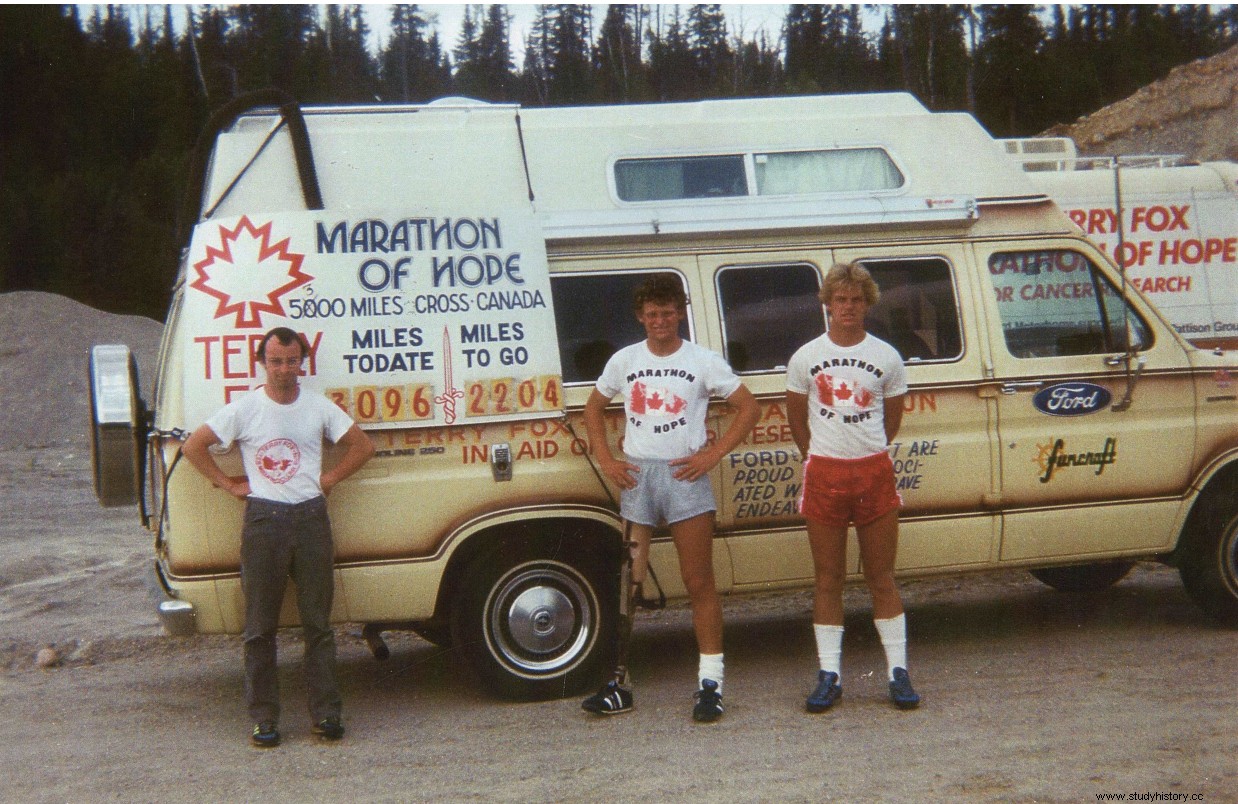
Marathon of Hope
Fox began its Marathon of Hope on April 12, 1980. Fox ran 42 km a day through the Atlantic provinces, Quebec and Ontario. He was supported by his best friend Doug Alward and his brother Darrell.
Media coverage was slow at first, but soon enough, communities in Newfoundland such as Grand Falls and Bishop's Falls came out to support Fox. Few people in Nova Scotia knew about Fox and the Marathon of Hope. According to Fox's diary, Price Edward Island was more hospitable. He was disappointed to know that nothing had been arranged for them in Saint John, New Brunswick. He and Alward decided to run through town, anyway. It was even tougher in Quebec - the Marathon of Hope had not been announced in the province, and he raised almost no money there.
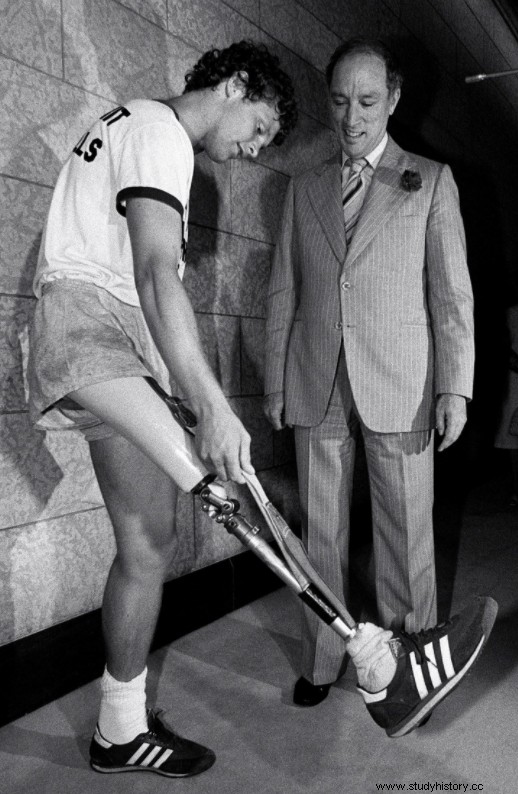
That changed, however, thanks to the efforts of businessman Isadore Sharp of the Canadian Cancer Society and journalist Leslie Scrivener of the Toronto Star. Scrivener wrote a weekly article on Fox's progress (and later wrote his biography).
When he reached Ontario, Fox was a national star, admired by thousands of performances organized by the Canadian Cancer Society. Fox met with Prime Minister Pierre Trudeau, British actor Maggie Smith and NHL players Bobby Orr and Darryl Sittler. Orr and Sittler presented the Fox NHL All-Star jersey from 1980. When he ran in Ontario, Fox was accompanied by the OPP (Ontario Provincial Police).
However, Fox was forced to stop running in Thunder Bay, Ontario, on September 1, 1980, when the cancer had spread to his lungs. On this day he ran for 143 days and covered 5,373 km - equivalent to 128 marathons. Fox promised that one day he would complete the cross-country race, but was unable to return.
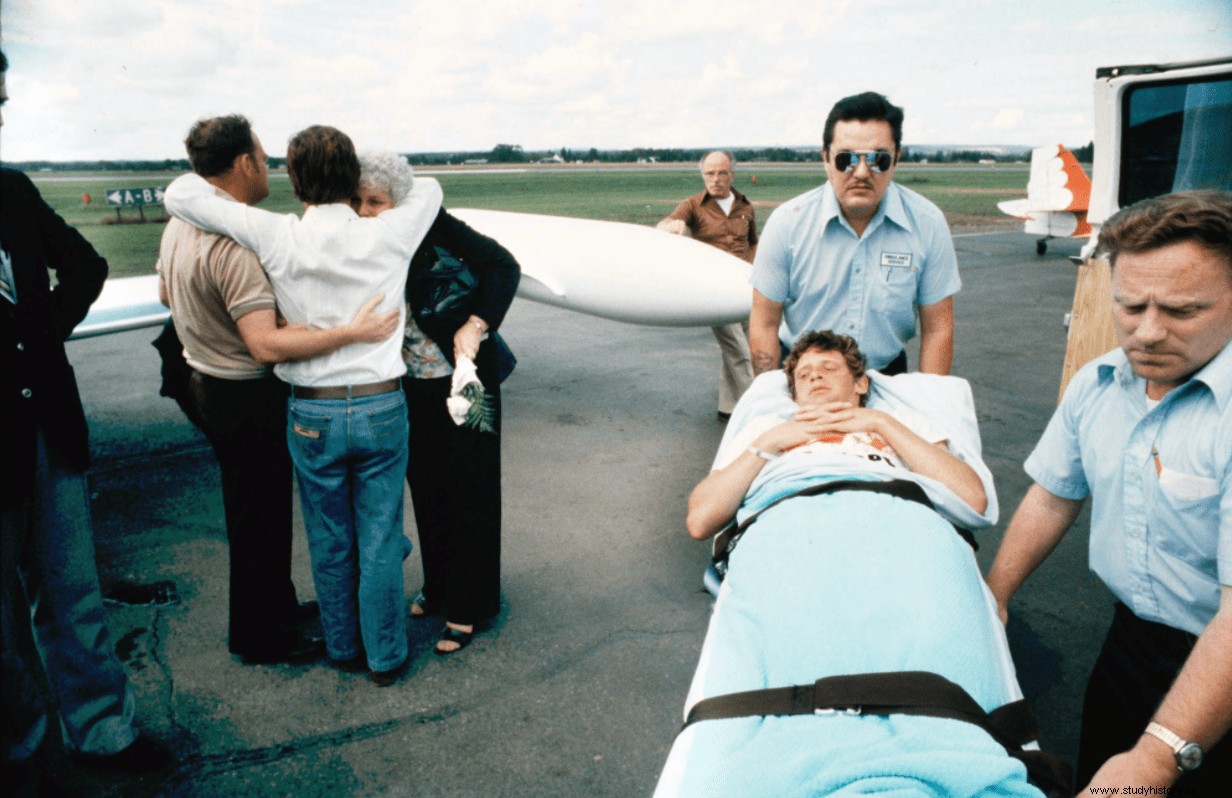
After the Marathon of Hope
When Fox stopped the race, his efforts inspired the rest of Canada. On September 7, 1980, CTV sent a telethon that raised $ 6.5 million in five hours. Less than two weeks later, Fox became the youngest person ever to join the Canadian Order. He was also awarded the Order of the Dogwood (the forerunner of the Order of British Columbia), the province's highest civilian honor. In December, he was named Canadian Press Newcomer of the Year and won the Lou Marsh Trophy as Canada's Athlete of the Year.
On February 1, 1981, Fox's Marathon of Hope raised $ 24.7 million for cancer patients. In early June, Simon Fraser University Fox presented the first Terry Fox Gold Medal. It is awarded annually to an SFU student who shows courage and possesses the qualities of a role model.
Months after undergoing treatment, Terry developed pneumonia in June 1981 and went into a coma on June 27. He died at Royal Columbian Hospital in New Westminster, 4:35 a.m. June 28. It was a month before his 23rd birthday. Prime Minister Trudeau told the House of Commons that day, "It is very rare in the life of a nation for the courageous spirit of a person to unite all people in the celebration of his life and in the grief of his death." On behalf of all Canadians, Trudeau expressed, "our deep gratitude for the gift that Terry gave to all of us, the gift of his own boundless courage and hope."
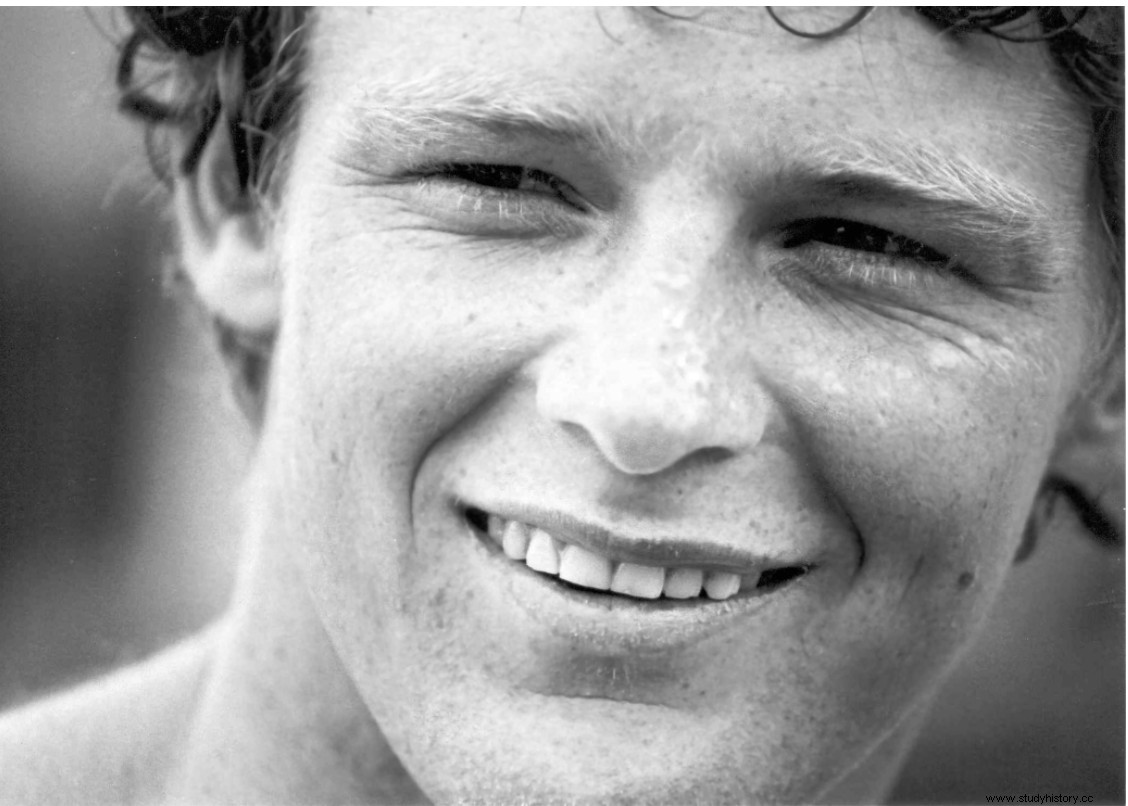
Honors
In the summer of 1981, the federal government established $ 5 million in Terry's name to provide scholarships to young Canadians. The Canadian Sports Hall of Fame inducted him into the honorary membership category. The Canadian Press named Fox News of the Year for the second year in a row. In April 1982, Canada Post issued a stamp in honor of Terry. In June 1982, a monument with a statue of Terry Fox was unveiled in Thunder Bay.
Schools, buildings and parks around Canada have been named in honor of Fox. BC, Manitoba and Ontario have attended the annual Terry Fox Day in his honor. On July 1, 1999, Fox was named Canada's largest hero in a national survey. In 2004, he was ranked number two after Tommy Douglas in the CBC Television program The Greatest Canadian. In April 2005, the Royal Canadian Mint issued a one-dollar coin to mark the 25th anniversary of the start of the Marathon of Hope.
At the Winter Olympics 2010 Games in Vancouver, Terry's mother, Betty, was one of the flag bearers who carried the Olympic flag during the opening ceremonies. In 2012, Fox was inducted into the Canadian Medical Hall of Fame for his efforts to raise money for cancer research. In 2013, Fox was inducted into the Canada Walk of Fame in Toronto. The Canadian Museum of History launched an exhibition on the Marathon of Hope in 2015.
Legacy
Fox's story has been told in books, movies — the Genie Award-winning The Terry Fox Story (1983) and Terry (2005) —and in a Heritage Minute. The ESPN documentary "Into the Wind" (2010) was directed by NBA star Steve Nash, who had repeatedly said that Fox was his personal hero.
Fox's goal of raising $ 1 for every Canadian with cancer, about $ 24 million, was reached on February 1, 1981. Since then, the fundraiser has continued in his name. His bravery and dedication have inspired many, including Steve Fonyo and Isadore Sharp, who hosted the first annual Terry Fox Run in 1981. Millions of people in Canada participate in the Terry Fox Run each year. The Terry Fox Foundation has raised more than $ 800 million for cancer research. The Terry Fox Research Institute in Vancouver was founded in 2007.
Awards
- Companion, Order of Canada (1980)
- Member, Order of the Dogwood (1980)
- Lou Marsh Trophy (1980)
- Canadian Press Newcomer of the Year (1980 and 1981)
- Inductee, Canada's Sports Hall of Fame (1981)
- Person of National Historical Importance, Government of Canada (2009)
- Inductee, Canadian Medical Hall of Fame (2012)
- Inductee, Canada's Walk of Fame (2013)
